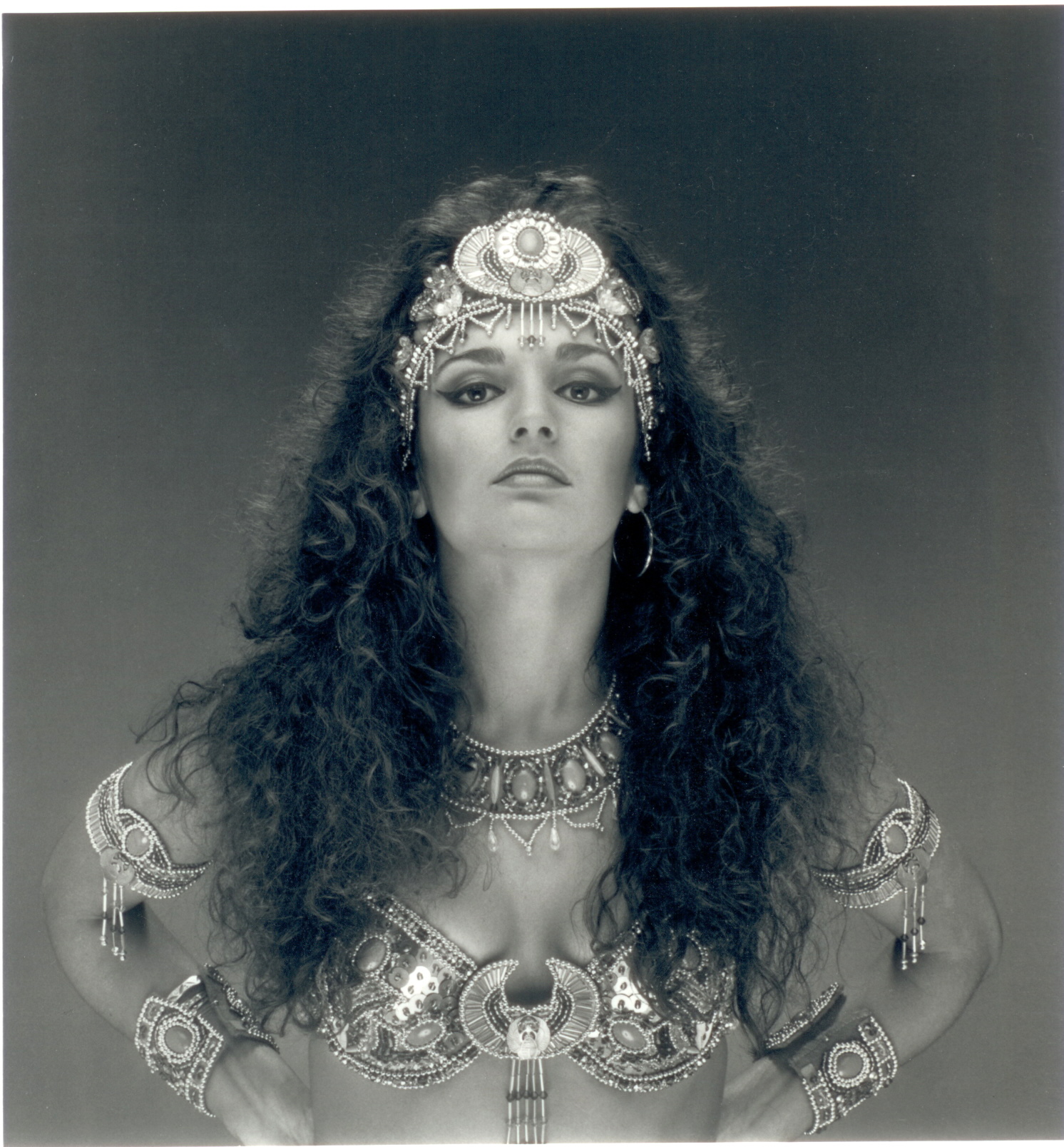When looking at the total of Suhaila’s recorded performances, you might notice that the “Pharaonic Suite” on the 1988 production Dances for the Sultan is different. The movements are highly stylized, bound, and deliberate. If you are familiar with more “traditional” interpretations of Arabic music, you might also notice that this particular work challenges those modes and turns them on their head. In the ouvre of Nadia Gamal, Suhaila has set choreography to every measure of these classic songs, even the taqasim.
Suhaila choreographed the suite, which she also calls “Karnak” (in reference to the ancient Egyptian-inspired costume that she wears in this performance), without input from her mother. In fact, it was the first time she created a piece without Jamila’s feedback, a sensation that she compares to riding a bike without training wheels. Unlike earlier works such as “Joumana,” “Hayati,” and “Maharajan,” where Suhaila would choreograph with her mother nodding in approval if she liked something or offering suggestions if she didn’t, Suhaila says that she felt that she had more room to play and experiment, without the responsibility of dancing in the “Jamila” style.
Indeed, the performances on Dances for the Sultan are decidedly experimental, when compared to the three earlier works in which Jamila gave her artistic input.
Primitivism, Erté, and Isolations
When we think of ancient Egyptian art, we might visualize those two-dimensional stelae, with goddesses and kings posed with their faces in profile, their torsos seen from the front, and feet turned in the direction of their facing. At the turn of the 20th century, this style of art spurred an entire aesthetic movement, often referred to as “Primitivism.” You can see how it influenced the subversive and ground-breaking choreographer Vaslav Nijinsky in his “Afternoon of a Faun.” (Watch how the nymphs enter the stage at around 2:50, and the faun’s own dancing throughout.) In fact, many of the Ballets Russes’ fin de siecle choreographies use primitivism. Movements are highly-structured, often direct, with bound arms at 90-degree angles, as if they had stepped off the walls of Tutankhamen’s tomb.
The two-dimensional approach to the human body is also seen in the work of Russian artist Erté, whose paintings depict women either posed directly from the front or directly from the side.
When I asked her, “Why Erté?” Suhaila responded that she always loved the design and lines in which Erté posed his women, but also because she felt that they look a bit sad. This influence is clear in the first 30 seconds of the performance, with the close-up on the young Suhaila’s face, before she spins into the Jamila Format Pyramid Step, her arms held firm out to the side, elbows at right angles, and palms facing upwards. At only a minute into the performance, she performs a series of rib cage and pelvic locks, arms traveling in a direct line from a high V, palms up, to a low V, palms down, hands parallel to the floor. She then follows the music in a series of pops from fingertips through the arms, through the torso, reversing in the hips and traveling up the body again.
Suhaila created the “The Pharaonic Suite,” after she begun her collaborative work with Oakland Boogaloo and tap dancer Walter “Sundance” Freeman. If you haven’t already, watch this video that the Salimpour School has created on Suhaila’s work with Walter. She was working on what she calls “crisp” isolations of the rib cage and pelvis, which had made an appearance in “Hayati” but had not yet been so prominently featured. In fact Syrian violinist and composer Fathi al-Jarrah, Suhaila’s long-time collaborator, remarked that he understood that Suhaila was blending hip-hop and belly dance in her early work. Her jazz training also becomes more integrated than in previous performances. Watch the section between 4:00 and 4:30 and you’ll see a textbook jazz pas du bourrée, into a turn and jazz layout. When we see these elements, it becomes easier to understand where now iconic works like “Bongo Funk” originated.
Indeed, it was these elements—Jamila Salimpour’s format, West Coast street dance, concert jazz dance, and a spirit of experimentation—that spurred Suhaila’s development of her now famous format. In “The Pharaonic Suite” we see her playing with these ideas, placing her movements on a solid “Home Position,” and building a foundation for a lifetime of work to come.
Subtle Irony
One of my earliest questions about this video was the title, Dances for the Sultan. It sounded so orientalist, so cheesy, so incongruent for a woman, dancer, and choreographer who has such great respect for and experience with Arabic culture and who has been such a strong advocate for women’s independence, strength, and fortitude. So, I asked. It turns out that the name is a bit of a joke. Tongue-in-cheek and ironic, it satirizes the role of the belly dancer in Arabic culture. It says to the iconic sultan, in his turban and salwar, sitting on his throne, smoking his shisha pipe, in control of everything he surveys, the paradigm of a Western idea of Oriental excess and indulgence: You want a dance? I’ll show you a dance.
Written by: Abigail Keyes (SSBD 5 and JSBD 5 certified instructor)






